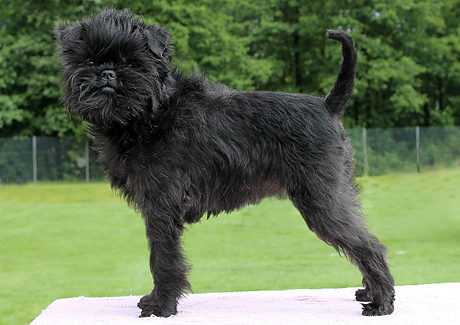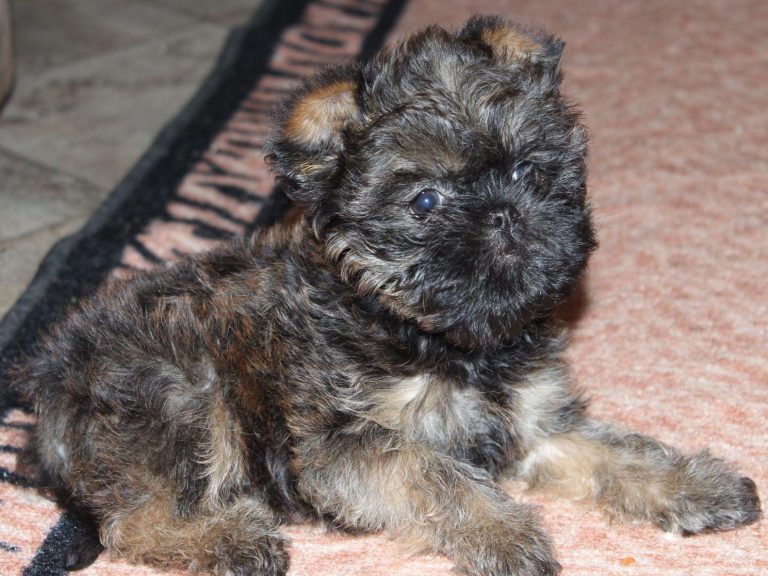Affenpinscher

ALTERNATE NAMES:
- Affen
- Affie
- African Terrier
- Monkey Dog
- Monkey Terrier
STATUS: Extant
GROUP: Terrier, AKC Toy
RECOGNITION:
ACA, ACR, AKC, ANKC, APRI, CKC (Continental Kennel Club), CKC (Canadian Kennel Club), DRA, FCI, KCGB, NAPR, NKC, NZKC
COUNTRY OF ORIGIN: Germany
HISTORY:
The exact history of the Affenpinscher is somewhat muddled, but we do know that terriers of this type (though slightly larger, at 12-13”) have been employed as ratters in Germany since around 1600. Known simply as Ratters, or Ratting Terriers, their job was to eliminate vermin on the farm, and so they were allowed to run at large during the day and sleep in the stables at night.
It was a fellow from Lubeck, Germany, who first began to breed these dogs intentionally, selecting for a smaller size so that they could be used as mousers in the home and family business. At this point, there two types of similar dog being bred: that which the man from Lubeck was developing, and a small Schnauzer type. Early breeders of these two types did quite a bit of crossing in order to come up with what they considered to be the ideal house dog. Some of these crosses included the Pug, the German Pinscher and the Silky Pinscher, and are the reason for the variety of colouring and hair types that the Affenpinscher has today.
South Russia was home to a small Schnauzer breed until about 1870, which was roughly 14” tall, dark grey in colour and which was used to hunt squirrels and martens. It is widely thought that this breed died out when their target prey became extinct in their homeland due to over-hunting. It’s believed that the dogs that were bred in Lubeck were the result of a cross between the Ratter and this Schnauzer type. As one (unknown) author put it: “there has always existed a breed of small, rough coated dogs, as early as the 15th century or before, and they were used for ratters and believed to be the forerunners of the present-day Affenpinscher”.
By the 18th century, there was a type of dog in Germany that more closely resembled the modern Affenpinscher, that was popularly called Schoosbundrassen (translated, loosely, as “pet dog”). At around 1720, there were two size types that resulted from the earlier crossing of the old-fashioned Affenpinscher-type dog and the Schnauzer from Russia, the largest of which eventually came to be known as the Miniature Schnauzer while the smaller type became what we know as the Affenpinscher.
TEMPERAMENT:
While the Affenpinscher falls into the category of terrier dog breeds, its history includes crosses involving other breed types, like the Schnauzer and the Pug. Schnauzers and Terriers are very similar as breeds, and so they tend to be very similar in temperament. That is to say, they are generally inquisitive, affectionate, playful and clever with a tendency to be quite a fearless little home defender. Terrier types, even small ones, may resort to being destructive if they aren’t stimulated enough, so exercise and plenty of playtime are key here.
From the mastiff side of things…let’s be honest, we’re using that term rather loosely here…they inherit an extra dose of stubbornness and a confident “big dog” attitude. Affenpinschers tend not to have a concept of their size, so they may pick an argument with a much bigger dog…which will probably end badly. Generally, Affenpinschers do get along well with other four-legged companions and older children, since they are very much a family dog. Still, things will work out best if they are raised in this kind of environment from puppyhood. Since they are a smaller breed of dog, having them in a home with small children may not work out well, since small children tend not to know their own strength and may inadvertently hurt the dog.
As with many breeds, firm and consistent boundaries need to be set and followed up on. The Affenpinscher will quickly take over leadership of the pack if its human buddy doesn’t establish themselves as the Alpha Dog.
BREED DESCRIPTION:
The Affenpinscher is a compact dog with a “wire” coat—that is, their shaggy fur is only marginally softer than, for example, human beard hair. Even without being trimmed, their coat tends to be longer around the face than on the rest of the body, giving them the monkey-like look that earned them the name of “Monkey Terrier.” This wiry coat is typically black or darker grey, but it possible to have shades of red, lighter gray or even black-and-tan.
The Affenpinscher’s body has a squared appearance, though they do have a deep chest and a slimmer waist. The head is round, with a pronounced stop (the ridge between the eyes, where the skull transitions to the muzzle). It has a short nose, though not as short as a Pug’s, and a slight underbite. Its lower front teeth protrude just below the nose.
For an official breed standard, please visit the American Kennel Club.
AVERAGE HEIGHT/ WEIGHT:
Height: 10-15″
Weight: 7-8lbs
GROOMING:
The Affenpinscher’s coat should not be clipped, as this can ruin the coat for many years. Instead, they should be brushed weekly and the hair around their ears should be plucked as needed to avoid infection. Dogs with wiry coats don’t shed the way many other breeds do. The coat will grow and then shed only once it has reached its maximum length…and it does not really leave the body without help.
Pet Affenpinscher dogs can be groomed with brushing and minimal other fuss, but show dogs are typically hand stripped. This means that the loose coat is removed by hand (or with a stripping knife) in order to make room for new growth to come in.
EXERCISE:
The Affenpinscher makes a good apartment dog, but they do still need daily walks and a safe outdoor place to play in. As with any dog, giving them enough exercise and stimulation is key to having a healthy, well-rounded dog.
HEALTH PROBLEMS:
- Affenpinschers can be prone to the following:
- Respiratory difficulty (especially in hot weather)
- Patent Ductus Arteriosus
- Patellar Luxation (AKA Slipped Stifle)
- Open Fontanelle (Note: a fontanelle that does not close after 12 weeks may lead to hydrocephalus.)
- Some Affenpinschers may be prone to bone fractures.
LIFE EXPECTANCY: 10-14 years
POINTS TO CONSIDER BEFORE BUYING:
Affenpinschers are:
- Highly intelligent.
- Excellent ratters.
- Stubborn and sometimes difficult to train.
- Not good at being left alone. They prefer near-constant human contact.
Did you know…
The Affenpinscher is technically part of the group of breeds collectively referred to as Pinschers, but since they did the kind of work normally associated with Terriers, they got lumped into that breed category instead!
